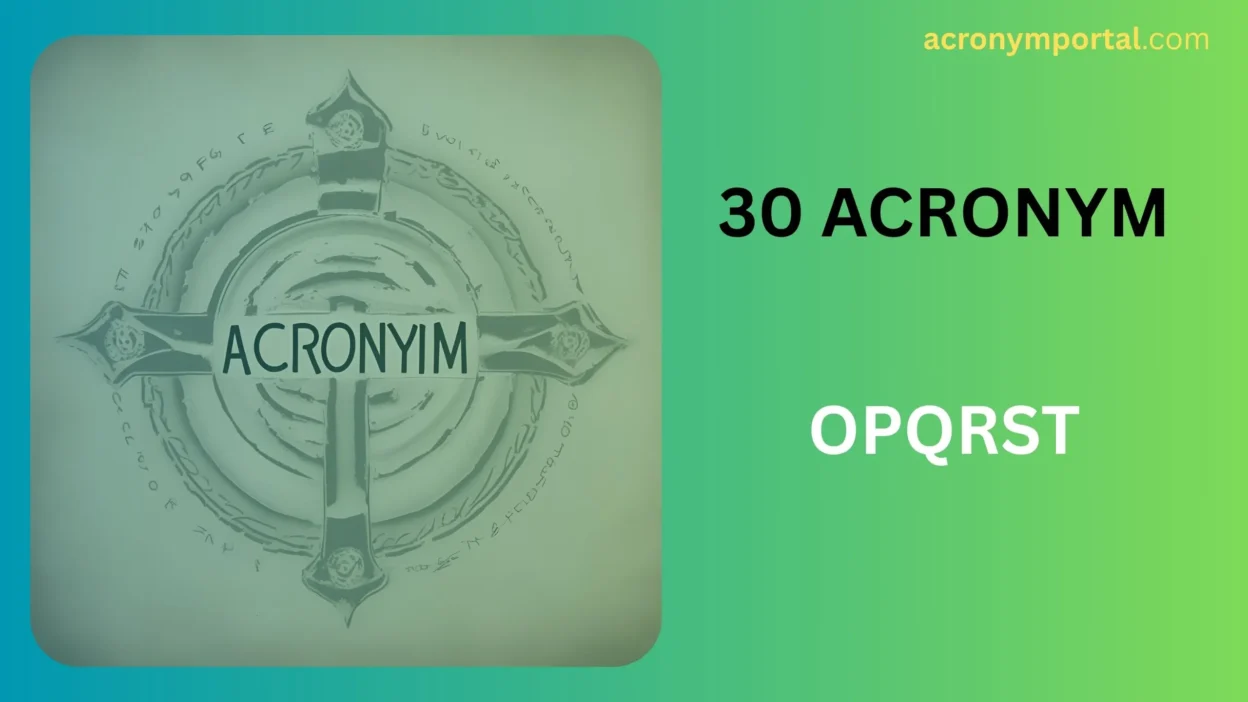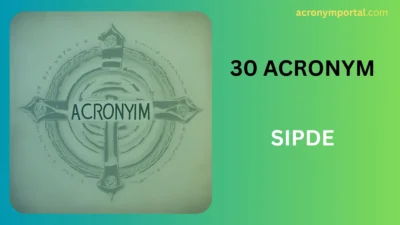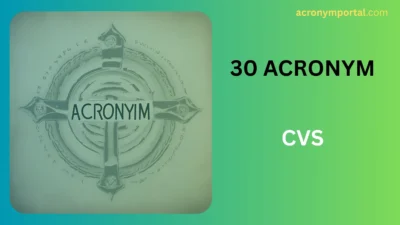When it comes to medical assessments, especially in emergency or first-response care, the term “OPQRST acronym” is a trusted and widely used memory tool.
It stands for Onset, Provocation, Quality, Region/Radiation, Severity, and Time—a framework designed to help healthcare professionals systematically evaluate a patient’s pain or symptoms.
But beyond the clinical world, the structure of OPQRST symbolizes something even more universally valuable: clarity, curiosity, empathy, and detail in understanding someone’s experience. In that broader, metaphorical sense, we can imagine OPQRST as representing thoughtful inquiry—asking the right questions, paying attention to pain points, and understanding people better.
So, in this article, we explore 30 alternative acronyms or expressions that align with the OPQRST mindset—phrases that reflect inquisitiveness, emotional sensitivity, and structured thinking.
Each one includes a short explanation, a practical example, and when it’s best used. Whether you’re a writer, caregiver, coach, or just a more attentive communicator, these expressions will help you articulate complex feelings and experiences more precisely.
🔄 30 Alternatives to the “OPQRST Acronym” Style of Inquiry
1. SOAP
Meaning: Subjective, Objective, Assessment, Plan – a medical documentation format.
Example: The doctor wrote her findings in a clear SOAP note.
When to use: Clinical settings; great for structured reporting.
2. OLD CARTS
Meaning: Onset, Location, Duration, Character, Aggravating/Relieving factors, Timing, Severity
Example: Using OLD CARTS helped the nurse get a complete pain history.
When to use: Ideal for pain or symptom assessment.
3. HEADSS
Meaning: Home, Education, Activities, Drugs, Sexuality, Suicide – used in adolescent health interviews.
Example: The clinician used HEADSS to build rapport with the teenager.
When to use: Youth and psychosocial evaluations.
4. PEARLS
Meaning: Partnership, Empathy, Apology, Respect, Legitimization, Support – tools for better patient communication.
Example: Using PEARLS helped ease the patient’s anxiety.
When to use: For emotionally sensitive interactions.
5. ABCDE
Meaning: Airway, Breathing, Circulation, Disability, Exposure – emergency assessment steps.
Example: Paramedics followed ABCDE during trauma response.
When to use: Emergency care triage and treatment.
6. SPIKES
Meaning: Setting, Perception, Invitation, Knowledge, Emotions, Summary – for delivering bad news.
Example: Doctors use SPIKES when sharing difficult diagnoses.
When to use: End-of-life care, serious news delivery.
7. BATHE
Meaning: Background, Affect, Trouble, Handling, Empathy – behavioral counseling framework.
Example: The therapist used BATHE to uncover emotional stressors.
When to use: Mental health check-ins and empathetic conversations.
8. SBAR
Meaning: Situation, Background, Assessment, Recommendation – for clear communication among clinicians.
Example: The nurse used SBAR to update the doctor on a patient’s status.
When to use: Clinical handovers, healthcare teamwork.
9. PQRST
Meaning: Provocation, Quality, Region, Severity, Timing – a pain assessment acronym.
Example: She used PQRST to understand her migraine symptoms.
When to use: Focused pain evaluations.
10. AMPLE
Meaning: Allergies, Medications, Past history, Last meal, Events leading up – emergency intake tool.
Example: Before surgery, the EMT collected AMPLE history.
When to use: Trauma and urgent situations.
11. FIFE
Meaning: Feelings, Ideas, Function, Expectations – explores patient perspective.
Example: The physician used FIFE to understand how the illness affected her daily life.
When to use: Patient-centered care conversations.
12. ICE
Meaning: Ideas, Concerns, Expectations – quick framework in general practice.
Example: ICE helped the doctor discover the patient feared cancer.
When to use: Primary care, short consultations.
13. RED FLAGS
Meaning: Warning signs that indicate a serious condition.
Example: He looked for red flags before prescribing medication.
When to use: Risk evaluation, cautionary analysis.
14. CHART
Meaning: Chief complaint, History, Assessment, Rx (Treatment), Test results
Example: The clinician updated the CHART after every visit.
When to use: Medical documentation.
15. SOLER
Meaning: Sit, Open posture, Lean, Eye contact, Relax – active listening body language.
Example: Using SOLER made the patient feel truly heard.
When to use: Counseling, deep listening situations.
16. NURS
Meaning: Naming, Understanding, Respecting, Supporting – emotional validation framework.
Example: She used NURS to acknowledge the patient’s grief.
When to use: Empathic communication moments.
17. PAIN
Meaning: Pattern, Area, Intensity, Nature – basic pain evaluation steps.
Example: He explained his back pain using the PAIN structure.
When to use: Simple symptom descriptions.
18. ICEBERG
Meaning: What’s seen vs. underlying issues (metaphor-based).
Example: The therapist looked for iceberg issues behind the anxiety.
When to use: Psychological, emotional writing.
19. GOLDEN HOUR
Meaning: The critical window after trauma for best survival outcomes.
Example: In the golden hour, fast treatment saved his life.
When to use: Emergency and trauma storytelling.
20. RAPID
Meaning: Recognize, Assess, Prioritize, Intervene, Disengage – used in crisis de-escalation.
Example: The team used RAPID during a psychiatric emergency.
When to use: Behavioral health or public safety contexts.
21. STOP
Meaning: Stop, Think, Observe, Plan – decision-making framework.
Example: Before reacting, he remembered to STOP.
When to use: Mindfulness, de-escalation, self-checks.
22. TEACH
Meaning: Tell, Explain, Ask, Check, Help – patient education tool.
Example: She used TEACH to ensure the patient understood his medication.
When to use: Health communication and instruction.
23. WILDA
Meaning: Words, Intensity, Location, Duration, Aggravating/Alleviating factors
Example: WILDA helped identify fibromyalgia patterns.
When to use: Chronic pain descriptions.
24. SAFER
Meaning: Stabilize, Acknowledge, Facilitate, Encourage, Refer – used in crisis counseling.
Example: In emotional crises, SAFER provides a quick response plan.
When to use: Mental health emergencies.
25. ABCDE-TIPS
Meaning: A trauma mnemonic including Temperature, Infection, Poisoning, Shock, etc.
Example: He used ABCDE-TIPS in a complex ER case.
When to use: Emergency medicine deep dives.
26. CARES
Meaning: Connect, Ask, Respond, Empathize, Support
Example: Nurses used CARES to support families during loss.
When to use: End-of-life, hospice care.
27. BRIGHT
Meaning: Breathing, Response, Irritability, Gaze, Heart rate, Tone
Example: Used BRIGHT to assess newborn distress.
When to use: Neonatal and pediatric assessments.
28. REACT
Meaning: Recognize, Evaluate, Act, Communicate, Track
Example: The team used REACT in infection outbreak drills.
When to use: Public health or emergency preparedness.
29. LORAZ
Meaning: Level of consciousness, Orientation, Responsiveness, Alertness, Zest (energy)
Example: He seemed altered, so they checked LORAZ quickly.
When to use: Mental status checks.
30. OPQRSTU
Meaning: Adds “U = You” (how the patient understands the pain).
Example: OPQRSTU makes the patient part of their own assessment.
When to use: Empowering patient-centered communication.
🧭 Choosing the Right Acronym or Framework
Here’s how to match the method to the moment:
- Structured assessment? Use OPQRST, SOAP, or PQRST.
- Emotional care? PEARLS, BATHE, NURS, or SPIKES work best.
- Mental health or behavior? Use HEADSS, SAFER, or RAPID.
- Fast decisions or safety? STOP, REACT, or ABCDE are most effective.
- Need empathy? CARES and FIFE shine when compassion matters.
Always consider audience, emotional weight, and time sensitivity. Some frameworks are clinical and fast-paced, while others are slow, deep, and emotionally rich.
🔚 Final Thoughts
The OPQRST acronym teaches us to ask questions with purpose, not just curiosity. Each alternative in this list helps you communicate more intentionally—whether in a hospital, in writing, or in emotionally sensitive conversations.
Choosing the right acronym isn’t just about remembering letters—it’s about remembering the human being behind those symptoms, stories, or silences.




